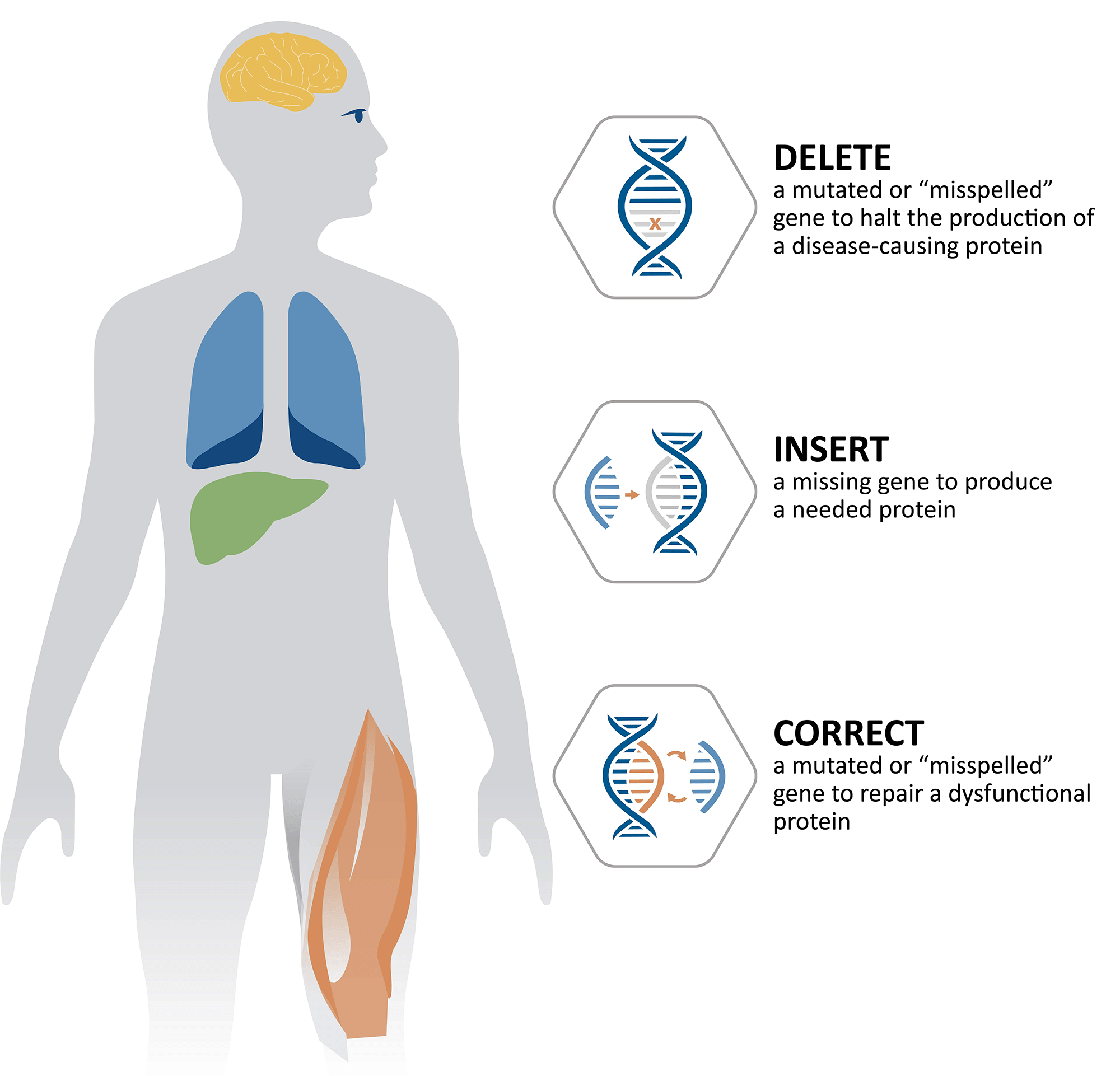Complete Gene Insertion: Advances In Precise Gene Editing Technology

Table of Contents
CRISPR-Cas9 and its Role in Complete Gene Insertion
CRISPR-Cas9, a revolutionary gene editing tool, has significantly advanced our ability to perform precise gene editing, including complete gene insertion. This system utilizes a guide RNA molecule to direct the Cas9 enzyme, a nuclease, to a specific DNA sequence in the genome. Cas9 then creates a double-strand break at the target site. The cell's natural DNA repair mechanisms are then harnessed to introduce the desired gene. This process utilizes either non-homologous end joining (NHEJ), which can result in insertions or deletions, or homologous recombination (HR), which allows for precise gene insertion using a DNA template containing the desired gene.
- Mechanism of action: Target recognition via guide RNA, DNA cleavage by Cas9, repair via NHEJ or HR using a donor template containing the gene of interest.
- Advantages: High efficiency, relatively simple to design and implement, cost-effective compared to other gene editing methods, and highly versatile.
- Limitations: Off-target effects (Cas9 cutting at unintended sites), challenges in efficient delivery of the CRISPR-Cas9 system and the donor DNA template into target cells, and ethical considerations surrounding germline editing.
Advanced Gene Targeting Techniques for Complete Gene Insertion
While CRISPR-Cas9 dominates the gene editing field, other precise gene editing technologies contribute to complete gene insertion. These include TALENs (Transcription Activator-Like Effector Nucleases) and ZFNs (Zinc Finger Nucleases). These systems use different protein domains to target specific DNA sequences, but like CRISPR-Cas9, they also create double-strand breaks that trigger DNA repair pathways, facilitating gene insertion. Homologous recombination plays a vital role in the precise integration of the new genetic material.
- TALENs: Offer high specificity but are more complex and expensive to design compared to CRISPR-Cas9.
- ZFNs: Were among the earliest gene editing technologies, offering good specificity but are often more challenging and expensive than CRISPR-Cas9.
- Homologous Recombination: This natural cellular process is crucial for precise gene insertion. It uses a homologous DNA template to repair the double-strand break, effectively replacing the targeted sequence with the new gene.
Overcoming Challenges in Complete Gene Insertion
Effective complete gene insertion faces significant challenges, particularly regarding delivery and minimizing off-target effects. Efficient delivery of the gene editing machinery and the donor DNA template to the target cells is crucial.
- Viral delivery vectors: Adeno-associated viruses (AAVs) and lentiviruses are commonly used, offering high transduction efficiency but with limitations regarding packaging capacity and potential immunogenicity.
- Non-viral delivery methods: Lipid nanoparticles and electroporation offer less immunogenicity but often have lower efficiency.
- Strategies for reducing off-target effects: Improved guide RNA design, use of high-fidelity Cas9 variants, and employing multiple gene editing components to enhance specificity are crucial.
Therapeutic Applications of Complete Gene Insertion
The potential therapeutic applications of complete gene insertion are vast and transformative. It allows for the correction of genetic defects by introducing functional genes to replace non-functional ones.
- Genetic diseases: Complete gene insertion offers the potential to cure single-gene disorders like cystic fibrosis, sickle cell anemia, and hemophilia by adding a functional copy of the defective gene.
- Cancer therapy: It can be utilized in CAR T-cell therapy to engineer immune cells to target cancer cells more effectively, or to directly edit tumor cells to make them more susceptible to treatment.
- Regenerative medicine: Complete gene insertion holds immense potential for regenerative medicine applications by enabling the precise modification of cells for tissue regeneration and repair. For example, introducing genes that promote cell growth or differentiation.
Examples of successful gene therapy using complete gene insertion: Although still in early stages, several clinical trials demonstrate the potential of this approach in treating various diseases. Further research will continue to expand the successful applications of this technology.
Conclusion: The Future of Complete Gene Insertion in Gene Editing
Complete gene insertion represents a significant leap forward in precise gene editing. While challenges like efficient delivery and off-target effects need further attention, the potential of this technology to revolutionize medicine and improve human health is undeniable. Its applications in treating genetic diseases, cancer, and regenerative medicine are rapidly expanding. By continuously refining techniques and addressing limitations, the future of complete gene insertion promises a new era of therapeutic possibilities. Learn more about the exciting advancements in complete gene insertion and how this technology is transforming the field of gene editing.

Featured Posts
-
 Na Thorups Ontslag Augsburg Op Zoek Naar Een Nieuwe Trainer
May 30, 2025
Na Thorups Ontslag Augsburg Op Zoek Naar Een Nieuwe Trainer
May 30, 2025 -
 Kawasaki W800 My 2025 Spesifikasi Dan Harga Terbaru Dengan Sentuhan Klasik
May 30, 2025
Kawasaki W800 My 2025 Spesifikasi Dan Harga Terbaru Dengan Sentuhan Klasik
May 30, 2025 -
 Miami Open Ealas Stunning Win Propels Her To Quarterfinals
May 30, 2025
Miami Open Ealas Stunning Win Propels Her To Quarterfinals
May 30, 2025 -
 Trumps Trade War 8 Key Impacts On The Canadian Economy
May 30, 2025
Trumps Trade War 8 Key Impacts On The Canadian Economy
May 30, 2025 -
 Bill Gates Accuses Elon Musk Of Contributing To Child Poverty Musks Response
May 30, 2025
Bill Gates Accuses Elon Musk Of Contributing To Child Poverty Musks Response
May 30, 2025
Latest Posts
-
 Griekspoor Stuns Zverev In Indian Wells Second Round
May 31, 2025
Griekspoor Stuns Zverev In Indian Wells Second Round
May 31, 2025 -
 Griekspoor Pulls Off Major Upset Against Zverev At Indian Wells
May 31, 2025
Griekspoor Pulls Off Major Upset Against Zverev At Indian Wells
May 31, 2025 -
 Zverev Loses To Griekspoor In Indian Wells Shock
May 31, 2025
Zverev Loses To Griekspoor In Indian Wells Shock
May 31, 2025 -
 Zverevs Road To The Munich Semifinals A Comeback Story
May 31, 2025
Zverevs Road To The Munich Semifinals A Comeback Story
May 31, 2025 -
 Tallon Griekspoor Defeats Alexander Zverev At Indian Wells
May 31, 2025
Tallon Griekspoor Defeats Alexander Zverev At Indian Wells
May 31, 2025
